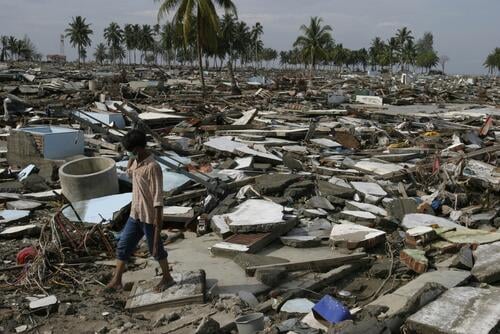Introduction
Days after an enormous tsunami battered parts of South East Asia on December 26, 2004, Médecins Sans Frontières (MSF) teams began working alongside national efforts to provide assistance to individuals in need of medical care, food, water, shelter and other basic necessities.
MSF offices sent over 200 volunteers who concentrated their efforts on hard-hit communities in Sri Lanka and Indonesia, with smaller scale activities in Thailand, Malaysia and India. Assessments completed by MSF teams across the tsunami region showed different needs in different countries, but it became quickly apparent that medical needs were limited.
The mobilisation of national emergency services and civil society saved the largest number of lives in the first crucial days. MSF saw its main role as identifying needs that were being overlooked.
In Thailand, MSF responded by helping Burmese migrant workers who found themselves in a particularly precarious position. In India, MSF offered psychological support. In Sri Lanka, where the damage was more extensive, MSF initially provided medical assistance and distributed relief goods.
But by far the greatest focus of MSF activities has been in Aceh, Indonesia, where many key health personnel were killed in the tsunami, and the health infrastructure destroyed.
Despite predictions and popular belief, huge epidemics did not occur. Now, a year later, MSF has reorientated its work in Indonesia, where 55 international and 350 national staff continue to work, and has finished its tsunami-related programmes in other countries. Within Aceh, MSF is anticipating scaling down its activities over the next year.
Throughout its intervention, MSF has remained determined that its programmes be driven by need alone, and not by a desire to spend surplus funds. Perhaps the most controversial decision MSF made during the tsunami response was to stop accepting funds which could be used to help victims of the tsunami less than a week after the disaster.
Despite this announcement, in an extraordinary outpouring of solidarity, MSF sections received in total 110 million euros while a forecast indicated that 25 million euros would be sufficient to run programmes for the rest of 2005. MSF decided to contact its donors, asking their permission to derestrict their donations so that they could be used for other emergencies and forgotten crises. The response was overwhelmingly positive. Of all the people contacted, 1% have asked for their money to be refunded rather than redirected.
By the end of 2005, MSF will have used 90.1 million euros or 82% of the tsunami donations to fund its operations in the tsunami region (Mââ?š¬24.7) and to meet urgent needs in other emergencies and forgotten crises (Mââ?š¬65.4) such as the nutritional crisis in Niger, the conflict in Darfur and the earthquake in Pakistan.
Remaining funds allocated for operations in 2006/7 will primarily be used for emergencies and forgotten crises. MSF will nevertheless continue activities in Aceh, where teams still find unmet medical needs with regard to vaccination programmes, mother-child health and with infectious diseases like tuberculosis.
Few other organisations are running psychologist-led mental health programmes leaving those traumatised by the tsunami and conflict with few places to turn. MSF is also exploring the inland area of Aceh which few NGOs have accessed but where it is known decades of fighting has taken its toll.



